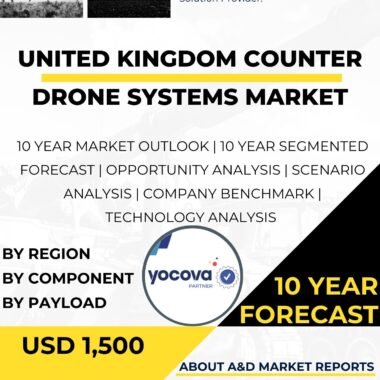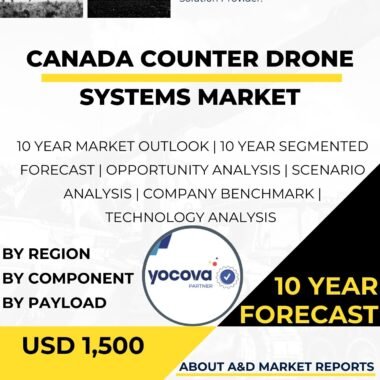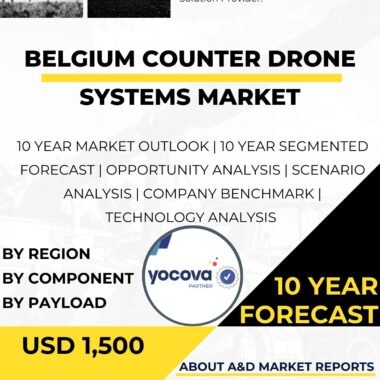Description
The Australia Counter Drone Systems Market is a critical and rapidly growing sector that plays a pivotal role in enhancing the country’s security and protecting its critical assets from the threats posed by unmanned aerial vehicles (UAVs) or drones. As drones become more accessible and affordable, their potential misuse for nefarious activities, such as espionage, terrorism, and smuggling, has raised concerns among authorities worldwide, including Australia. The Australia Counter Drone Systems Market focuses on developing and deploying innovative technologies and solutions to detect, identify, track, and neutralize rogue drones in various environments, including urban areas, critical infrastructure, military installations, and public events. This article provides a comprehensive analysis of the Australia Counter Drone Systems Market, covering its current state, key drivers, challenges, applications, technological advancements, and growth prospects.
The Australia Counter Drone Systems Market has witnessed significant growth and interest due to the increasing number of drone-related incidents and the potential security risks associated with drones. Rogue drones can pose threats to national security, public safety, and the privacy of individuals, making the development of effective countermeasures a top priority for the Australian government and security agencies.
One of the key drivers behind the market’s prominence is the rapid proliferation of drones in the civilian and commercial sectors. Drones are now commonly used for various legitimate purposes, such as aerial photography, surveying, delivery services, and agriculture. However, their widespread availability has also opened the door for malicious actors to exploit drones for illicit activities. As a result, the demand for counter drone systems has surged, aiming to safeguard sensitive areas and mitigate potential threats.
Moreover, the Australia Counter Drone Systems Market is driven by the need to protect critical infrastructure and public safety. Critical infrastructure, such as airports, power plants, government buildings, and military installations, is vulnerable to drone-related disruptions and attacks. Counter drone systems are deployed to create no-fly zones and detect unauthorized drones in these sensitive areas, preventing potential incidents and ensuring the continuity of essential services.
The market’s growth is also influenced by Australia’s strategic interests in safeguarding major public events. Sporting events, concerts, political gatherings, and other mass gatherings are susceptible to drone-related risks, such as surveillance, contraband delivery, or direct attacks. Deploying counter drone systems in these scenarios enhances security measures and provides peace of mind to organizers and attendees.
The Australia Counter Drone Systems Market encompasses a range of technologies and solutions tailored to meet the diverse needs of different sectors and environments. These countermeasures can be broadly categorized into detection, identification, tracking, and mitigation systems.
Detection systems are designed to identify the presence of unauthorized drones in a given area. They utilize various sensors, including radar, radio frequency (RF) scanners, acoustic sensors, and optical cameras, to detect the drone’s signals or physical presence. Upon detection, these systems can trigger alerts to security personnel or operators, initiating appropriate response measures.
Identification systems go a step further by determining the type and model of the detected drone. This information is crucial for assessing the potential threat level posed by the drone and determining the appropriate response strategy. Identification can be achieved through RF fingerprinting, drone database comparison, or visual identification.
Tracking systems enable continuous monitoring and tracking of the drone’s movement once detected and identified. These systems use sophisticated algorithms and sensors to predict the drone’s trajectory and maintain its visual tracking. Tracking is essential for understanding the drone’s intent and behavior, especially if it enters restricted airspace or approaches sensitive areas.
Mitigation systems are designed to neutralize the detected drone and prevent it from carrying out its mission. Various countermeasures are available, including radio frequency (RF) jamming, GPS spoofing, laser-based systems, and physical interception mechanisms. However, it is essential to deploy mitigation systems with caution, ensuring minimal collateral damage and adherence to legal and ethical considerations.
Despite the market’s growth and potential, the Australia Counter Drone Systems Market also faces certain challenges. One significant challenge is the need for continuous research and development to stay ahead of drone technology advancements. As drone capabilities evolve, including increased range, autonomy, and stealth features, counter drone systems must keep pace to effectively detect and neutralize advanced drones.
Moreover, addressing the issue of drone proliferation and affordability is essential for optimizing the deployment of counter drone systems. As drones become more accessible and inexpensive, the potential for misuse by non-state actors and individuals increases, necessitating a scalable and cost-effective countermeasure approach.
Additionally, ensuring the security and reliability of counter drone systems themselves is of paramount importance. These systems rely on cutting-edge technologies and sensitive data to detect and mitigate drone threats. Robust cybersecurity measures and secure communication networks are necessary to protect these systems from potential cyber threats.
Looking ahead, the Australia Counter Drone Systems Market is expected to witness continued growth and advancements. As the threat landscape evolves and drones continue to gain popularity, the demand for innovative and comprehensive counter drone solutions will remain strong. Continued investment in research and development, collaboration between the government and industry stakeholders, and a focus on addressing technical challenges will drive advancements in counter drone technology and applications.
In conclusion, the Australia Counter Drone Systems Market is a strategically vital sector that contributes to the country’s security and safeguards its critical assets from potential drone-related threats. Counter drone systems play a crucial role in detecting, identifying, tracking, and mitigating rogue drones in various environments, including critical infrastructure, public events, and military installations. The market’s growth is driven by the increasing use of drones and the associated security risks, necessitating advanced technologies and solutions to protect Australia’s interests and enhance public safety. Addressing challenges related to technology development, affordability, and security will be crucial to unlocking the full potential of the Australia Counter Drone Systems Market and strengthening the country’s counter-drone capabilities for the future.




